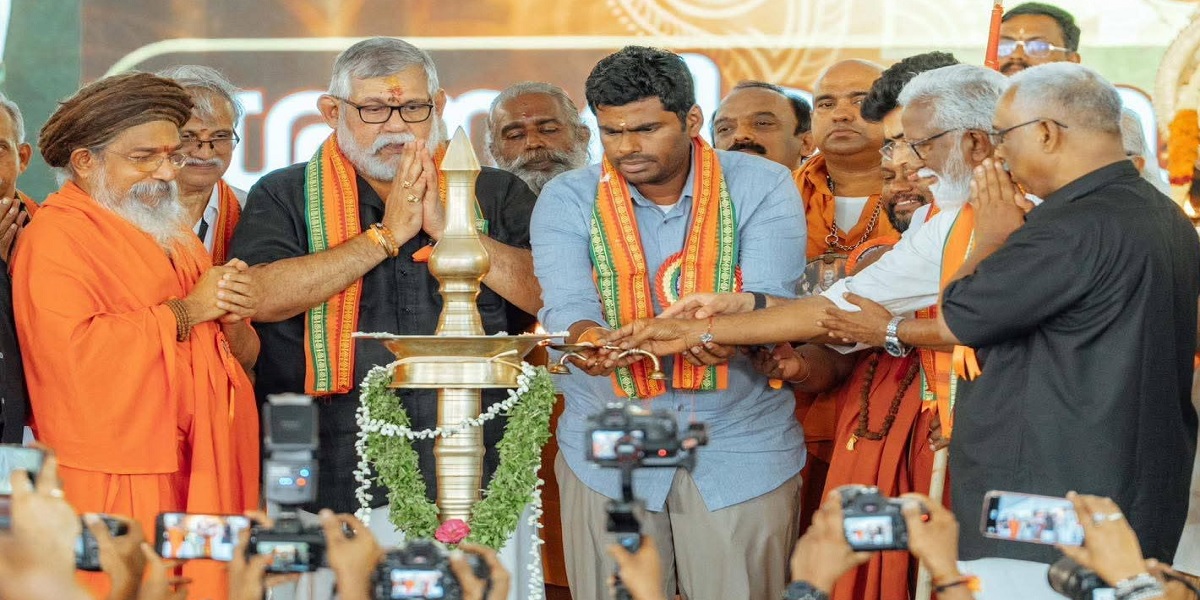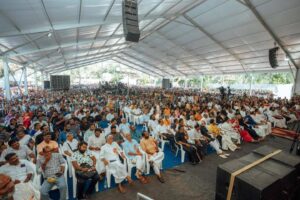The BJP, which won control of the Pandalam municipality in the 2020 local body elections and retained the neighbouring Kulanada panchayat, appears poised to make further inroads into the Travancore region, a traditional Congress stronghold.
Published Sep 23, 2025 | 8:00 AM ⚊ Updated Oct 17, 2025 | 11:26 AM

Former Tamil Nadu BJP president K. Annamalai inaugurated the Sabarimala Samrakshana Sangamam held in Pandalam
Synopsis: Recently, Pamba and Pandalam, two of Kerala’s sacred sites associated with Lord Ayyappa, became arenas for political and ideological contestation between the ruling LDF and the BJP, as the Global Ayyappa Sangamam at Pamba and the Sangh Parivar’s Pandalam event competed to woo devotees. The gatherings signalled the growing influence of Ayyappa in Kerala politics in the run-up to the 2026 Assembly elections. Whether invoking the deity and his legacy will yield electoral dividends, particularly for the BJP, which has long sought to expand its limited base in Kerala, remains to be seen.
The river Pamba, often called the Ganga of Kerala, is where, according to legend, Lord Ayyappa was discovered as an infant. Pilgrims take a ritual dip here before beginning their trek to the Sabarimala temple.
Nearby, Pandalam is revered as the home of the Pandala dynasty king who raised Ayyappa. It is regarded as the deity’s birthplace, making both sites deeply significant in Kerala’s religious imagination.
In recent weeks, these two sacred locations have also become the stage for political and ideological contestation, drawing in the Communist Party of India (Marxist)-led Left Democratic Front (LDF) and the BJP-led Sangh Parivar, along with allied Hindu organisations.
The LDF government organised the Global Ayyappa Sangamam at Pamba. In response, BJP-backed Hindu groups hosted the Sabarimala Samrakshana Sangamam in Pandalam, inaugurated by former Tamil Nadu BJP president K Annamalai.
For the LDF, still bruised by electoral setbacks after its bid to implement the Supreme Court’s 2018 order permitting women of menstruating age into Sabarimala, the Pamba gathering was widely seen as a strategic U-turn ahead of the 2026 Assembly elections.
For the BJP and its allies, the Pandalam meeting was an emphatic counter-event, marked by sharp attacks on Chief Minister Pinarayi Vijayan and overt appeals to Ayyappa devotees across the state.
“Both the CPI(M) and BJP are trying to capitalise on their ‘love’ for Lord Ayyappa. The CPI(M) is particularly concerned about further erosion of the Ezhava vote, as a significant number of Ezhava voters shifted to the BJP after 2018,” Roy Matthew, a political observer, told South First.
The Pandalam event saw participation from the Rashtriya Swayamsevak Sangh, Vishva Hindu Parishad, Hindu Aikya Vedi, and several Hindu sanyasins from across India.
In his address, Annamalai ridiculed Chief Minister Vijayan:
“The same Pinarayi who once declared that there is no God is now lecturing on the Bhagavad Gita. Those who dismissed Lord Ganapati as a myth are taking spiritual classes. What happened in 2018 is being repeated here in Pandalam.”
He referred to the 2018 Sabarimala controversy, when widespread protests erupted against the government’s attempts to implement the Supreme Court order. The political fallout hurt the LDF in the 2019 Lok Sabha elections.
Annamalai also criticised the government for inviting Tamil Nadu Chief Minister MK Stalin to its Ayyappa event:
“The event was organised only after seeing the DMK’s Global Muruga Sangamam. Neither Vijayan nor Stalin are worthy of leading such gatherings. The Gita itself says those who act in this manner will fall into hell. Vijayan should reflect on that part of the scripture, considering what he did in 2018.”
The Global Ayyappa Sangamam at Pamba gained added weight with the participation of the Nair Service Society (NSS) and the Sree Narayana Dharma Paripalana Yogam (SNDP), two of the most influential caste organisations in the state. Their involvement gave a political boost to the LDF and an unexpected setback to the BJP.
Initially, BJP state president Rajeev Chandrasekhar strongly criticised the event. But after the NSS and SNDP’s presence became clear, his tone softened, likely to avoid a backlash.
By contrast, the Pandalam event did not see official participation from major caste organisations. Critics interpreted this as a sign that the BJP has yet to secure their confidence.

Even though the Sabarimala Samrakshana Sangamam drew a significant number of Ayyappa devotees from the Ezhava and Nair communities, there was no official representation from either the NSS or SNDP.
“The contrast between the Pamba and Pandalam events lies in the stance of the SNDP. Vellappilly Natesan, SNDP’s chief, supported the government’s event, while his son, Thushar Vellappally, now the chief of BDJS [Bharath Dharma Jana Sena, a BJP ally] supported the Pandalam event organised by the Sangh Parivar. This has left the community heads confused,” Matthew explained.
“The BJP has limited cards to play in Kerala, its strategy has consistently revolved around religion and Sanatana Dharma. This mirrors Tamil Nadu’s political pattern, though the deities differ – Murugan there, Ayyappa here.”
According to right-wing activist Rahul Easwar, while bodies like NSS and SNDP were absent officially, many Nair and Ezhava devotees took part individually.
He further noted that the government’s Pamba meet saw only one representative from Tamil Nadu, while the Pandalam gathering drew leaders such as K Annamalai and Tejasvi Surya from Karnataka.
Easwar also criticised the Travancore Devaswom Board for “failing to ensure the effective conduct” of the Pamba programme, contrasting it with what he described as the Sangh Parivar’s organisational success at Pandalam. He added that Uttar Pradesh Chief Minister Yogi Adityanath had also sent greetings to the event.
Even so, BJP spokesperson Sandeep Vachaspati insisted that the Sabarimala Samrakshana Sangamam was not a counter to the LDF’s programme. He argued that the participation of groups like NSS and SNDP in the Pamba event did not mean they endorsed the government’s earlier stance on women’s entry into Sabarimala.
Meanwhile, the Pandalam royal family—the traditional custodians of Ayyappa lore—remained silent on the government’s Pamba initiative, citing recent bereavements. The family’s management committee, while staying away, reiterated two long-standing demands: withdrawal of cases related to the 2018 protests and firm assurances on preserving temple traditions. Both remain unaddressed.
In contrast, members of the royal family actively participated in the Sangh Parivar-backed event at Pandalam.
The BJP, which won control of the Pandalam municipality in the 2020 local body elections and retained the neighbouring Kulanada panchayat, appears poised to make further inroads into the Travancore region, a traditional Congress stronghold.
The choice of Pandalam for this event also reflects the BJP’s strategy of consolidating its strongholds before attempting to expand into new areas.
Hindu Aikyavedi spokesperson E S Biju said the scale of participation was telling:
“Representatives from over 120 community organisations attended the Pandalam event, along with members of the Sabarimala Thantri family. The Thantri Samajam and Yogakshema Sabha also expressed support for the BJP, welcoming the Pandalam event and questioning the authenticity of the government-organised Pamba event.”
Not everyone agreed. Dr B Jayaraj, political analyst and Left sympathiser, said criticisms of the Global Ayyappa Sangamam were misplaced:
“Some media outlets highlighted empty chairs and claimed that only 600 people attended, which is baseless. The objective of the Global Ayyappa Sangamam was never to showcase political strength but to focus on the Sabarimala Master Plan and the temple’s sustainable development.”
He argued that the BJP’s event in Pandalam carried a different tone:
“In contrast, the event in Pandalam ended up spreading hatred by questioning the authenticity of Vavar Swamy, who is believed to have been a Muslim and a close companion of Lord Ayyappa.”
Dr Jayaraj also corrected one of Annamalai’s remarks:
“[He] wrongly claimed that the Chief Minister quoted the Bhagavad Gita, whereas the reference was actually from the Upanishads.”
Nevertheless, Roy Mathew pointed out that the BJP’s recent gains cannot be ignored.
“BJP’s vote share in Kerala has risen to nearly 20 percent. Its influence is not confined to Travancore or Central Travancore – previous elections showed significant vote shifts to BJP even in parts of Malabar,” Matthew noted.
“The Ayyappa factor could extend further into Malabar because devotees, even those who follow Muthappan, local lords, tend to remain loyal to the faith everywhere.”
He highlighted specific regions where the BJP has made headway since the 2018 Sabarimala controversy.
“In Alappuzha, the stronghold of KC Venugopal, and in Kayamkulam and Haripad, the home turf of Chennithala, the BJP has gained significant votes and support since the 2018 Sabarimala controversy. Hindu communities, once averse to the BJP, now openly declare their support – a phenomenon Kerala had never witnessed before,” he said.
He added that the BJP’s current strategy is shaped by setbacks in other communities:
“Another reason behind BJP’s emphasis on Ayyappa devotion is the backlash from Christian communities after attacks on priests and nuns in North India by Hindu organisations and the exposure of Munambam’s unfulfilled promises. This has restored confidence in Congress, especially under leaders like VD Satheesan, who attended around 60 Christian congregation meetings in 2025 alone. As minority votes did not come to the BJP as expected, the party is relying on Hindu voters, and evoking Ayyappa devotion is the easiest way.”
According to him, the Pandalam event was an indicator of what lies ahead:
“The Pandalam event signals that BJP’s experiments in Kerala are set to continue and could have a pan-Kerala impact.”
The core issue now is whether invoking Lord Ayyappa and contesting his legacy will bring electoral dividends, particularly for the BJP, which has long sought to expand its limited base in Kerala.
For the LDF, the challenge lies in balancing secular commitments with the sentiments of a vast and devout Ayyappa constituency – one that continues to shape the political experiments unfolding on the banks of the Pamba and in the heart of Pandalam.
